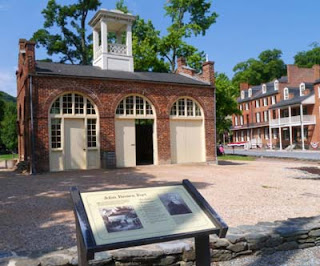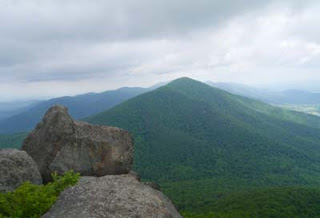 |
| View of Mount Rogers and Wilburn Ridge from the top of Little Pinnacle |
After enjoying 6 out of 7 days of clear weather, it
looked like rain was headed our way again.
But rain or not both David and I had been looking forward to our next
side trip off the Parkway. We were
headed into the southwestern corner of Virginia to Grayson Highlands State
Park.
 |
| Clear view across Grayson Highland from Big Pinnacle, a rare sight |
The park is flanked by the two highest peaks in the
state, 5,729-foot Mount Rogers and 5,520-foot Whitetop Mountain. Truly a high land, Grayson Highlands is the
realm of the clouds, spruce-fir forests, flower-dotted balds grazed by wild
ponies, miles of hiking and horse trails plus a section of the Appalachian
Trail. After our wonderful AT hike at
Roan Mountain we were anxious to hike again in spruce-fir forests and balds
and, OK, I admit it - I am a sucker for horses.
Maya, our trail finder in the fog...
We arrived at the park around noon, set up camp and
hurried out for a quick hike as the rain was fast on its way. The Twin Pinnacles Trail had been recommended
to us by fellow campers at Stone Mountain (Maya’s dog friends, Lulu and Star’s
owners) as a great trail to take to get a good view of the park. The clouds were rolling in, but it was still
clear enough to get good views of Mount Rogers and Wilburn Ridge. As it turned out it was a very good thing we
went when we did. The views quickly disappeared into clouds not to return again
while we were there.
Ponies in the mist...
The next day fog clung to the trees and mist dripped from
everything. But we were still determined
to take our hike up near Mount Rogers. One
thing we have learned is that you can be ‘socked in’ at one location and a short
distance away, things can be much clearer.
So with all our rain gear either on our bodies or in our packs we headed
up the Rhododendron Trail to the Appalachian Trail and then to Mount Rogers
just outside the park in the Jefferson National Forest.
Mare near foaling time
Paint stallion
The weather went from rain to barely misty to fairly
clear and back – over and over again. There were times we could barely see 10 feet
in front of us and times we could see about half a mile. Everyone had told us that the ponies had been
seen but not to count on it as they often remain hidden in the forests or the
high brush. We thought they could be
right in front of us and we might not be able to see them because of the fog. During some good visibility on the first half
of our hike we spotted a mare and young colt at a distance and were thrilled to
see them. They were far away so I didn’t
get good photos but we were just glad that we got to see them.

But then on the way down from Mount Rogers our luck went from
so-so to amazing. We saw four separate
bands of ponies each with a stallion, several mares, yearlings and young colts. Two of the bands were at a distance but we
got very close to the other two bands. The
ponies are wild and the park encourages visitors not to approach them or feed
them. But they have become accustomed to
people and aren’t disturbed if you walk calmly around them (and many AT hikers
do).

The ponies are not native to the park. Throughout North Carolina and Virginia in the
‘bald’ areas of the Appalachians and Blue Ridge Mountains, different techniques
have been used to keep the balds bald.
Mowing, burning and the introduction of grazing animals have all been
used. In the 1970’s, the Wilburn Ridge
Pony Association was formed. They bought ponies and released them at Grayson
Highlands and the Mount Rogers area to graze the balds. It has been working well although some of the
balds are being invaded by high brush that the ponies have not been able to
graze down. Every fall, the pony association
holds a round up and sells some of the excess ponies to keep the herds healthy
and the population stable for the land available.
Stallion in the mist
One of the bands of ponies we passed close to had a
couple of young foals. The herd was right in the trail and we slowly
walked by being careful not to upset the moms.
But one of the foals thought that Maya was just the perfect size for a
playmate. It was just precious how
curious and how much the foal wanted to get close to Maya. Finally we just gave us and let them sniff
noses. But little ponies and herding
dogs don’t really speak the same language and we did not let the games begin.
New buddies...
As David and I were watching our little band of ponies (I
called them ours because we spent so much time with them), we were privileged
to see a drama unfold before us. Another
band of ponies ran by us and the two stallions challenged each other. It was getting incredibly foggy as all this
was taking place, so David and I couldn’t see everything. It appeared to us that the stallions were
equally matched and that mostly a lot of posturing was all that happened. But as the second stallion and his band moved
on, one of his mares slipped away and remained with ‘our’ band and stallion.
The new mare (on the right) with 'our' stallion
The band stallion staying close to the new mare
Our stallion was very happy to have a new mare but his
mares were not too sure about the new girl.
A lot of sniffing and some biting and chasing went on. It was getting later and foggier and we had been
watching ponies a long time, so we headed back to camp before we were sure of
the outcome. I like to think the new
mare was accepted.
Another mare about to foal
It would have been fascinating to stay for weeks or even
months watching the herds and seeing their lives unfold. We were going to hike back up the next day to
see if we could see ‘our’ band of ponies again, but thunder storms and flash
flood warnings made that impractical. Still,
we felt incredibly fortunate to have seen four bands of ponies and to get to
spend such a long time with one.
David's Stats:
Days Hiked 2
Total Miles Hiked 12.25
Ave. Miles per Day
6.13
Total Elevation Gain 2,181
Ave. Elevation Gain per day 1,091



























































